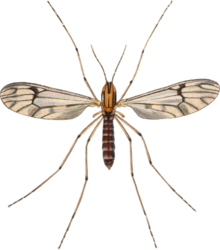TheDixidae(meniscusmidges) are afamilyofaquaticnematoceranflies(Diptera). Thelarvaelive in unpolluted, standingfresh waters,just beneath the surface film, usually amongst marginal aquatic vegetation.[2][3]They are found in all continents except Antarctica.
| Dixidae Temporal range:
| |
|---|---|

| |
| Dixa nebulosa | |
| Scientific classification | |
| Domain: | Eukaryota |
| Kingdom: | Animalia |
| Phylum: | Arthropoda |
| Class: | Insecta |
| Order: | Diptera |
| Superfamily: | Culicoidea |
| Family: | Dixidae Schiffner, 1868 |
| Genera | |
Description
editFor terms seeMorphology of Diptera
Dixidae are small (body length not more than 5.0 mm) slender gnats with thin legs. Adults are black to yellowish-brown.[4]The head is relatively broad. The antennae are thin and the flagellum has 14 segments. The proboscis is short and thick and the palpi are five-segmented. The thorax is slightly convex. The wing veins are without scales (with scales in the closely related familyCulicidae.The subcosta is fused with the costa at the level of the base of Rs or slightly proximal to this. The wing venation exhibits radial, medial, and cubital forks (R 4 branched, M 2 branched, Cu 2 branched). R 2+ 3 is strongly arched, the r–m crossvein is distinct, and the discal cell is absent. The anal vein of the wing is long. The genitalia of the male is inverted at 180° by torsion of segments 5–8.
Evolutionary history
editThe oldest known fossils of the group come from theJurassicof Asia, assigned to the extinct generaSyndixaandEucorethrina,members of modern genera are not known until theEocene.[5]
References
edit- ^Papp, L., Merz, B. & Földvari (2006):Diptera of Thailand. A summary of the families and genera with references to the species representations. Acta. zool. hung. Vol. 52 (2)
- ^R. W. Bouchard Jr. (2005).Guide to Aquatic Invertebrates of the Upper Midwest.University of Minnesota.Archived fromthe originalon 2009-03-05.Retrieved2007-06-30.
- ^R. H. L. Disney (1999).British Dixidae (meniscus midges) and Thaumaleidae (trickle midges): keys with ecological notes.Vol. 56.Freshwater Biological Association.pp. 128 pp.ISBN0-900386-60-6.
- ^New Zealand inventory of biodiversity.Dennis P. Gordon. Christchurch, N.Z.: Canterbury University Press. 2009–2012. p. 328.ISBN978-1-877257-72-8.OCLC340800193.
{{cite book}}:CS1 maint: others (link) - ^Greenwalt, D (2016)."The first fossil New World Dixidae with a critical discussion of generic definitions".Palaeontologia Electronica.doi:10.26879/656.ISSN1094-8074.
Further reading
edit- Lindner,E 193 1. Dixinae (Culicidae) 3, 11–12, 1-43 In: Lindner, E. (Ed.).Die Fliegen der Paläarktischen RegionKeys to Palaearctic species but now needs revision (in German).
- A. A. Shtakel'berg Family Dixidae inBei-Bienko, G. Ya,1988Keys to the insects of the European Part of the USSRVolume 5 (Diptera) Part 2 English edition.Keys to Palaearctic species but now needs revision.
External links
edit- Delta Int Key– family description and image
- BugGuide
- Wing venation
- EOLimages
- Diptera.infoimages
- Dixiidaein Italian